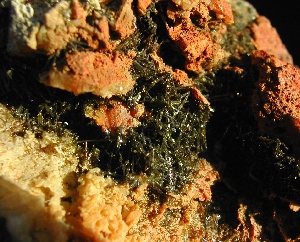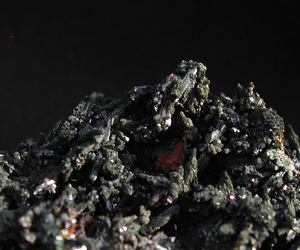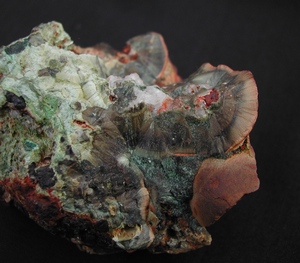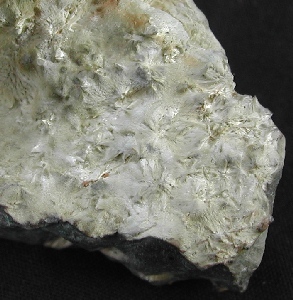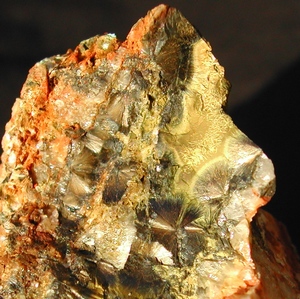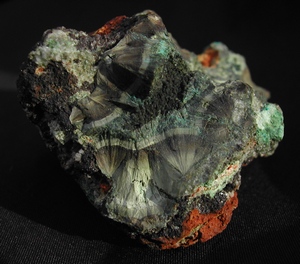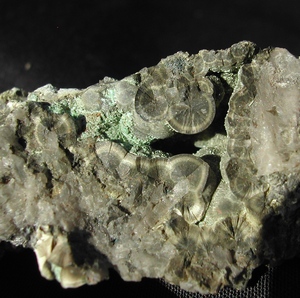|
|
|||||||||
 |
|
Olivenite, like Liroconite, is a secondary copper arsenate that varies widely in form. It is considerably less rare than Liroconite, but can be found associated with it in the same mineral veins. When first discovered in the mines in the St Day district of Cornwall Olivenite was sometimes found associated with Liroconite, and more commonly with Clinoclase. However, Olivenite is less rare than either Liroconite or Clinoclase and has now been found in many parts of the world. Some of the most notable locations besides Cornwall in the UK are Arizona, Nevada, and Utah in the USA, Tsumeb in Namibia, a number of sites in Germany, southern France, the Attiki area of Greece, and parts of South Australia. |
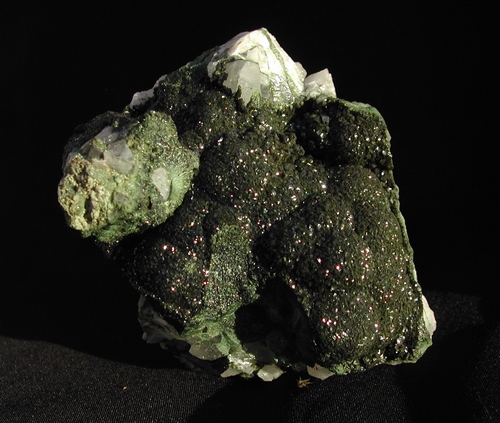 |
|||
|
Olivenite - Wheal Gorland, St Day, Cornwall, UK Dark olive green lustrous Olivenite crystals aggregated together thickly coating Quartz. A L McGuinness collection. |
|||
|
Olivenite Discovery The discovery of Olivenite is a fascinating and far from straightforward tale (many thanks to Nick Carruth who supplied material to help unravel the story). It involves a number of famous people including M.H Klaproth, who was the first to isolate a number of important elements and is regarded as the father of analytical chemistry. He discovered, almost as a by-product while working with minerals from all parts of the globe, a number of hither to unknown elements: Zirconium (1789), Uranium (1789), Titanium (1792), Strontium (1793), Chromium (1797) and Cerium (1803). The story begins in 1786 when Klaproth was analysing some new minerals from the Huel Virgin and Carrarach mines (now spelt Carharrack) in the Gwennap district of Cornwall. He describes an olive-green coloured mineral which he analysed as being "copper mineralised by the acid of Arsenic". This was almost certainly what we now know as Olivenite, but there is no analytical data and no specimen was preserved to confirm this. Klaproth's work was translated into English by John Gottlieb Groschke M.D. in the same year as published: "Observations relative to the Mineralogical and Chemical History of the Fossils of Cornwall" by Martin Henry Klaproth - London 1787. On pages 28/29, which covers copper ores, Klaproth writes the following: "....Azur copper ore, in quartz is met with at Huel Virgin and Carrarach ............(also) ..crystallisations ..consists of tender, olive-green coloured spiculae; these are about two or three lines long and stand straight up either single or fasciculated and radiated. They consist of copper mineralized by the acid of Arsenic". Martin Klaproth therefore described and analysed Olivenite, but no type specimen was preserved and he failed to provide it with a name. This was left to A.G.Werner to do a couple of years later, when in 1789 he gave it the German name Olivenerz which means "olive ore", after its olive-green colour. He described it as coming from Cornwall, providing no more accurate location. It was actually found from a number of mines in this area of Cornwall which in addition to Carharrack includes Wheal Gorland and Wheal Unity.
|
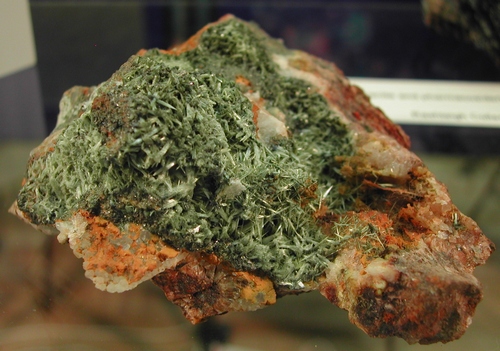 |
||
|
Olivenite - Wheal Fortune, Gwennap, Cornwall, UK Pale olive green fibrous Olivenite crystals varying considerably in colour and thickness from a very old and unusual mine. Royal Cornwall Museum Truro collection. |
||
|
In 1797 and 1802 Phillip Rashleigh refers to Klaproth's work in his famous illustrated books, calling the mineral Olive-green copper ore. It wasn't until 1820 that the name Olivenite was first used. R.Jameson (Syst. Min. 3rd Ed 2. 335) named the mineral Olivenite, so anglicising the Olivenerz of Werner. Unfortunately no more exact locality other than Cornwall is provided. Another difficulty is the use of the name in the various sections which appear to apply to more than just Olivenite as we now know it. So under the heading of 'Genus 111 Olivenite' he lists 4 sections:
Section 1 is probably Libethenite, Section 2 Liroconite, Section 4 Pharmacosiderite, with only Section 3 being the true Olivenite as we now know it. The name Olivenite was therefore originally aptly chosen due to the olive-green colour, but was then actually applied to several different arsenate minerals some of which had totally different colours including Liroconite! Variations of the name include: Olivenerz, Olivenit, Olivenita, Olivenkupfer. It has also been given a number of other names: Acicular arseniate of copper, Cuivre Arseniate, Laurochalcit, Laurochalcita, Laurochalcite, Pharmacholzit, Pharmacholzite, Pharmachalcit, Pharmachalcite, Pharmachalzit, Pharmachalzite, Pharmacolzit, Pharmakochalcit, Pharmakochalcite, Pharmakochalzit.
|
|
|
||||||||||||||||||||||||||||||||||||||||||||||||||||||||
|
Olivenite Habit & Form Olivenite, whilst also being a copper arsenate, is very distinct from both Liroconite and Clinoclase. Comte de Bournon in the early 19th century remarked "Nature has established very remarkable differences between the arseniates of copper." The appearance of Olivenite differs markedly from Liroconite, both in form and colour. Occasionally Olivenite occurs with Liroconite, and it then forms a wonderful contrast often leading to a beautiful display specimen. Olivenite can vary widely in appearance, ranging from lustrous prismatic dark green crystals to an almost white fibrous material. Often it forms sparkling 'nests' of acicular crystals. It can also form aggregates of crystals which are bunched together leading to an undulating botyroidal layer with a crystalline surface. Sometimes it is in the form of radiating fibres with varying bands of colour that resemble a section of wood. This form was therefore named 'Wood Copper' by the old Cornish miners. The surface of such material often has a velvet lustre. The colour of Olivenite can vary enormously, from a dark green almost black colour to a pale creamy-white, and every shade in between. The white, felt-like variety has been given the name 'Leucochalcite'. Crystals can also sometimes contain various zones of colour on the same crystal, this often being clearer under the microscope. However, unlike Liroconite or Clinoclase, it never assumes a blue colour. Possible colours include: Dark greenish black, olive green, greenish brown, brown, greenish yellow, yellow, and creamy white.
|
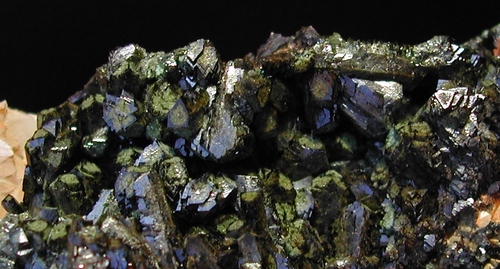 |
|
Olivenite - Wheal Unity, Gwennap, Cornwall, UK Large chunky dark zoned crystals to over 1 cm in length with mid green centres and dark green edges. Carl Bosch collection, US National Museum. |
 |
|
Olivenite - Cornwall, UK 'Arseniate of Copper minutely crystallised'. Sprays of thin acicular crystals of Olivenite forming a nest in a cavity of Quartz. Robert Fergusson collection. |
|
|
||||||||||||||||||||||||||||||||||||||||||||||||||||||||||||||||||||||||||||||||||||||||||||||||||||||||||||||||||||||||||||||||||||||||||||||
|
Olivenite Chemical Characteristics |
|
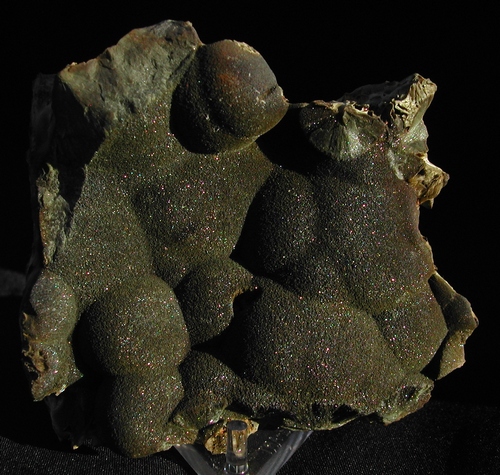 |
||||
|
'Cuivre Arseniate' Olivenite form 'Wood Copper' - St Day, Cornwall, UK Small olive green lustrous Olivenite crystals thickly coating 'Wood Copper'. Ex Paris School of Mines. |
||||
|
Olivenite Physical Characteristics |
||||
|
|
Copyright (C) 2003-2008 David Aubrey-Jones. All rights reserved. No part of this Web site and its contents may be reproduced in any form without the written permission of the author. |
|
[Liroconite] [Rarity] [Discovery] [Habit & Form] [Descriptions] [Locations] [Cornish Minerals] [Links] [About us] |
